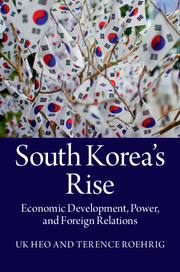Book contents
- Frontmatter
- Dedication
- Contents
- List of figures
- List of tables
- Acknowledgements
- 1 Introduction
- 2 Economic development, state power, and foreign policy
- 3 Inter-Korean relations: confrontation, economic exchanges, and the nuclear crisis
- 4 South Korea and the United States: from dependency to partnership
- 5 South Korea, Russia, and China: from adversaries to economic partners
- 6 South Korea and Japan: an ambivalent relationship
- 7 South Korea and the European Union: evolving cooperation and competition
- 8 South Korea and India: opportunities and obstacles
- 9 South Korea and the developing world: Africa, Latin America, the Middle East, and Southeast Asia
- 10 Contributing to the international community: from consumer to producer
- 11 Conclusion
- Bibliography
- Index
- References
4 - South Korea and the United States: from dependency to partnership
Published online by Cambridge University Press: 05 July 2014
- Frontmatter
- Dedication
- Contents
- List of figures
- List of tables
- Acknowledgements
- 1 Introduction
- 2 Economic development, state power, and foreign policy
- 3 Inter-Korean relations: confrontation, economic exchanges, and the nuclear crisis
- 4 South Korea and the United States: from dependency to partnership
- 5 South Korea, Russia, and China: from adversaries to economic partners
- 6 South Korea and Japan: an ambivalent relationship
- 7 South Korea and the European Union: evolving cooperation and competition
- 8 South Korea and India: opportunities and obstacles
- 9 South Korea and the developing world: Africa, Latin America, the Middle East, and Southeast Asia
- 10 Contributing to the international community: from consumer to producer
- 11 Conclusion
- Bibliography
- Index
- References
Summary
South Korea’s most important bilateral relationship with regard to security and economics is with the United States. When the ROK–US alliance began formally after the Korean War, the relationship was a highly asymmetrical patron–client one. In the years that followed, Washington was the primary guarantor of ROK security and sponsor of its economy. In turn, South Korea had a difficult time opposing US wishes as Washington could wield heavy economic and military leverage to coerce Seoul’s compliance.
As South Korea’s economy developed, so too did its power and position within the alliance. South Korea developed a formidable military that assumed a greater share of its own defense while also contributing to US and international security operations. The ROK economy ended its dependence on US economic and military aid, becoming a major economic power in its own right. Seoul was able to push the limits of the alliance for greater freedom of movement and the ability to pursue ROK interests as its leaders saw them.
- Type
- Chapter
- Information
- South Korea's RiseEconomic Development, Power, and Foreign Relations, pp. 50 - 66Publisher: Cambridge University PressPrint publication year: 2014

